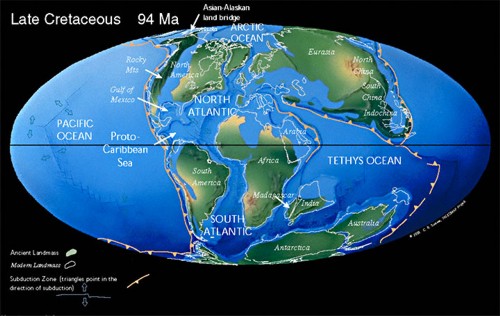![]() In my contribution to the recent debate over the relative evilness of volcanoes, I argued:
In my contribution to the recent debate over the relative evilness of volcanoes, I argued:
…life may sometimes be threatened by geology, but it is also intimately shaped by it.
At the time, I did wonder if what is – at least to us geologists – a fairly obvious point was not as fully appreciated by our biologist brethen as it should be. Since making it can apparently get you published in Science, it seems that this is indeed the case. Snark aside, however, Renema et al. have provided a very nice demonstration of how the creation and destruction of habitats by tectonic processes drive changes in biodiversity.
The story begins with the Indo-Australian Archipeligo, the region between the Malay Peninsula and northern Australia which includes the numerous islands of Indonesia and the Philippines. In the modern world, this is currently a ‘hotspot’* of marine diversity; this region is home to a larger number of different types of coral, and other shallow-water dwelling plants and animals, than anywhere else in the world. The big question is, why? Rather than looking to present-day geography and ecology for the answer, as many have done in the past, Renema et al. decided to take the longer view, by studying the last 40 million years of these groups’ evolutionary history, as recorded in the fossil record. They also looked at changes across an area much larger that the region of the present hotspot.
This detailed study revealed two interesting facts. Firstly, most of the groups responsible for the present high biodiversity first appear in the fossil record much longer ago than had previously been thought; rather than arising in the last three or four million years, many emerged almost 20 million years ago, in the Early Miocene. Secondly, when you go back even further in time, the current hotspot is shown to be merely the most recent in a series. 40 million years ago, in the Late Eocene, the area of greatest biodiversity was several thousand kilometres further to the west, in the Mediterranean. By the time the modern Indo-Australian hotspot was first warming up, this early hotspot had cooled, but marine diversity was in full flower on the margins of Arabia.
This slow eastward drift of the biological hotspot links nicely into a tectonic story; the final closure of the Tethys ocean. Way back in the Cretaceous, almost 100 million years ago, the world looked a little bit like this (this map courtesy of the Paleomap project):
Tethys was a seaway that separated Africa and India from Europe and Asia. During the Cretaceous and early Cenozoic, subduction beneath Europe and Asia caused this ocean to gradually shrink, and eventually close completely, forming the zone of continental collision that has produced the Alps and the Himalayas. However, because Tethys was narrower in the west than in the east, closure occurred much earlier in the Western Tethys than than in the Eastern Tethys, with the early stages of continental collision occurring in the Mediterranean region during the Eocene and in the Arabian region during the Early Miocene. Significantly, this is right at the times when these regions developed into biological hotspots. As deformation uplifts the ocean floor in the early stages of continental collision, and as various microcontinental fragments accrete to the subduction margin ahead of the main continent, you get an large but dynamic expanse of shallow shelf environments for shallow marine fauna and flora to flourish in, which could easily drive speciation and increasing biodiversity.
Unfortunately, the forces that create such biological hotspots also contain the seeds of their destruction; in the late stages of continental collision, the closure of the ocean and the uplift of mountain belts forces shallow marine species to migrate, or drives them to extinction. Thus these oases of biodiversity have vanished, the environments that produced and supported them crushed into non-existence by merciless orogenic forces. The closure of Tethys, and the migration of the region of maximum diversity over time, is shown nicely in Renema et al.’s Figure 1, which I’ve slightly adapted; note that only the data for one particular group, benthic foraminfera, are being used. For various reasons these shelly single-celled organisms have a very good and intensively studied fossil record, and changes in their biodiversity have been shown to mirror those for other shallow marine organisms with lower resolution records.

The Early Miocene also marks the early phases of collision between Indo-Australia and Asia, so it is no suprise that this is when biodiversity first began to ramp up in the region of the present hotspot, as well. But, although it has survived to the present day, as with it’s earlier cousins, this hotspot will eventually also fade away, as Australia drifts further north, and the intervening seaways close up. Geology rules – and life must adapt, or die.
*If you’re reading hotspot and thinking of volcanoes, you’re not the only one. Typical biologists, nicking geological terminology because they can’t think up their own…

Renema, W., Bellwood, D.R., Braga, J.C., Bromfield, K., Hall, R., Johnson, K.G., Lunt, P., Meyer, C.P., McMonagle, L.B., Morley, R.J., O’Dea, A., Todd, J.A., Wesselingh, F.P., Wilson, M.E., Pandolfi, J.M. (2008). Hopping Hotspots: Global Shifts in Marine Biodiversity. Science, 321(5889), 654-657. DOI: 10.1126/science.1155674




Comments (5)